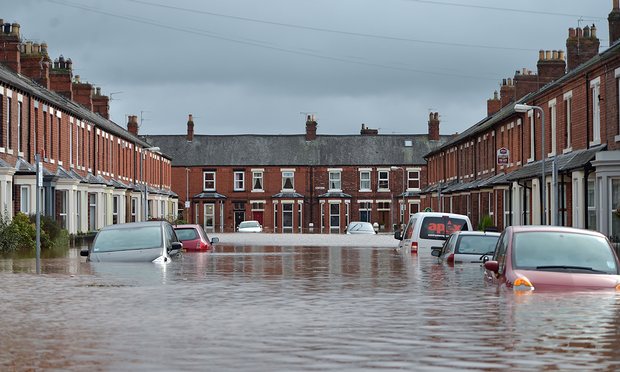Densely populated and developed, urban infrastructure comprises
layers of impermeable surfaces – roads, buildings, concrete. Our sewage
systems funnel and channel water, speeding up water flow and taking
water away to reservoirs and waterways.
The Victorian approach
effectively ‘waterproofed’ our cities by preventing rainwater from
naturally absorbing into the ground. In modern times, this approach
leaves our cities heavily vulnerable to climate change, which predicts
higher frequency of extreme weather events, including rainfall.
Channelling run-off into our already overloaded drains and sewers means
that cities can quickly flood during heavy rainfall. The first London
Sustainable Drainage Action Plan says the capital’s sewer network will
be at full capacity by 2050, leaving the city vulnerable to flooding
from even relatively light rain.
Our cities need to adapt to climate change, by slowing water down, fast. |
 |
Trees offer a resilient and sustainable future for our cities. They are
multi-functional assets, delivering ecosystem services such as reducing
flood risk, whilst also improving air and water quality, regulating
temperature, and supporting biodiversity. In terms of mitigating flood
risk, urban trees absorb surface water through their roots and intercept
rainfall with their branches and leaves, helping to reduce and slow
down the flow of rainfall to the drainage system. They are also
beautiful, transforming our grey cities! Caroline Russell, London
Assembly member for the Green Party, calls for more city trees in her
recent article,
‘Trees are as crucial to how London works as trains and drains’, and the London Sustainable Drainage Action Plan seeks to “roll
back the tide of grey, impermeable surfaces and replace them with a
mosaic of green ‘sustainable drainage’ systems”

|
Trees for Cities
delivers a wide range of community tree planting projects in urban
schools, housing estates, parks and streets. We were delighted when our
street tree planting project on Crown Woods Way in Greenwich won ‘Most
Innovative’ category at the 2015 Big Biodiversity Challenge Awards.
Delivered in conjunction with a Stockholm SuDS system installed by the
Royal Borough of Greenwich, Trees for Cities took a holistic and
sustainable approach to improve surface water management to reduce flood
risk on a residential street in Eltham adjacent to the A2. The planting
combined planting street trees alongside wildflowers in rain gardens
and engaging the local residents to help care for the trees. The project
demonstrates how green infrastructure can be utilised as an effective
sustainable urban drainage system on a small scale appropriate for
streets and roadsides. An approach that helps reduce surface water
flooding whist also mitigating noise, screening traffic, helping to
reduce air pollution, and all whilst improving the aesthetics of the
public realm for the local community.
|
The BIG Biodiversity Challenge Awards were a fantastic opportunity to receive industry recognition for the quality of our work and showcase Trees for Cities as an experienced partner to deliver green infrastructure and biodiversity initiatives. It also helped to demonstrate the value of holistic approaches to create multi-functional spaces that achieve wide ranging benefits and promote cross-sector collaboration, leading to the planning and delivery of more Green Infrastructure projects across London. Since the award, Trees for Cities has partnered with Lambeth Council on a flood alleviation plan for Ruskin Park, using tree planting and rain gardens as a sustainable approach to mitigate flooding whilst improving biodiversity, and ensuring there are trees in the park for future generations to enjoy. We are also working with L&Q on a green infrastructure project as part of the Barking Riverside development in Barking and Dagenham.
By 2050, up to 75% of us are predicted to live in cities, increasing pressure on land for housing and development. As our cities continue to grow, we have a responsibility to plant trees and protect and maintain our green spaces to ensure our cities are also liveable, maximising the functionality, efficiency and quality of the space we have. This challenge is seen in the new Mayor’s Manifesto, with the top priority being to build thousands of more homes in London each year, whist creating a greener, healthier city.
When development costs run over budget the trees are often the first to go, or are added as an afterthought in design of outdoor spaces. Trees for Cities wants more than to retrofit green infrastructure into existing spaces; making the best of what’s left. We want to work with developer’s right from the start of planning to incorporate trees as multi-functional assets to meet the complex needs of our cities. Creating high-quality agile spaces that are beautiful, healthy and sustainable places for communities to thrive.
So get in touch! Let’s see how we can work together.
Kate Halahan, Trees for Cities
[email protected]
The BIG Biodiversity Challenge is free to enter
and the deadline is August 8, with the 2016 awards ceremony taking
place on September 15 in a central London venue. There are also fantastic sponsorship opportunities for organisations wanting to be involved in this year’s Awards
ceremony. For further information on how to enter, and to be inspired by
last year’s entries, please visit www.bigchallenge.info